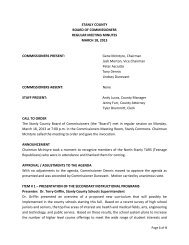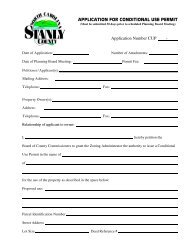Land Use Plan – 2002 - Stanly County, North Carolina
Land Use Plan – 2002 - Stanly County, North Carolina
Land Use Plan – 2002 - Stanly County, North Carolina
You also want an ePaper? Increase the reach of your titles
YUMPU automatically turns print PDFs into web optimized ePapers that Google loves.
Traditional Neighborhood Design<br />
How It Works<br />
Strengths<br />
STANLY COUNTY<br />
Traditional Neighborhood Design (TND) is a pattern of development and design that provides<br />
neighborhoods that are walkable in scale and mixed in use. This walkability is a result of an<br />
interconnected street network, streets with sidewalks and street trees, and smaller residential<br />
setbacks; while a mix of uses results from residential uses being located “above the store” on<br />
the second floor. If this model sounds familiar, it is because it is the model of design for most all<br />
cities, towns, and other population centers in <strong>Stanly</strong> <strong>County</strong> before World War II.<br />
TND, which is also known as the new urbanism, or neo-traditional design, was popularized by<br />
Andreas Duany and Elizabeth Plater-Zyberk of the firm DPZ in Miami, Florida in the late 1980s<br />
as a reaction to the unmitigated sprawl development model practiced in the U.S. since the<br />
1950s. TND-planned communities have been developed throughout the country including<br />
several in the Charlotte region (Vermillion in Huntersville). The plan for the city of Locust is<br />
based on TND principles.<br />
Hamlets in <strong>Stanly</strong> <strong>County</strong> are typically focused at the intersection of two major roads and many<br />
times can be a focal point for the surrounding countryside. Additional growth of a hamlet, based<br />
on traditional neighborhood principles, can create a regional pattern of growth where pedestrian<br />
oriented development is focused around the hamlets while the surrounding farmlands or<br />
countryside is preserved as open space. In these cases the TND model can be combined with<br />
the conservation development model (discussed above) to provide a smooth transition from<br />
relatively dense hamlets to medium density residential development to open countryside.<br />
As part of an overall county plan that outlines the concept, future development could be<br />
concentrated near, or as part of existing hamlets, instead of sprawling out over the countryside.<br />
The appropriate implementation mechanisms would be required to be adopted such as a land<br />
use plan that outlines the traditional neighborhood planning principles, a transfer of development<br />
rights policy, an updated zoning ordinance, and building design guidelines. The combination of<br />
these elements provides the framework to guide growth in this manner.<br />
The following strengths are associated with the TND model:<br />
TND can be a part of an overall county plan to help concentrate development in the hamlets<br />
and villages while retaining open spaces in surrounding areas.<br />
TND is an incentive/market based system as developers and land owners sell development<br />
rights to transfer development to hamlets based on market values.<br />
Environmentally friendly by concentrating development in small areas and preserving other<br />
open spaces rather than spreading development out over the whole county.<br />
Promotes walkability and non-motorized modes of transportation as land uses are integrated<br />
on a site-specific basis.<br />
Is an efficient use of financial resources as road, water, and sewer infrastructure serving<br />
new development is concentrated in the villages rather than spread out in a haphazard<br />
pattern throughout the countryside.<br />
<strong>Land</strong> <strong>Use</strong> <strong>Plan</strong> 6-24 6/02






